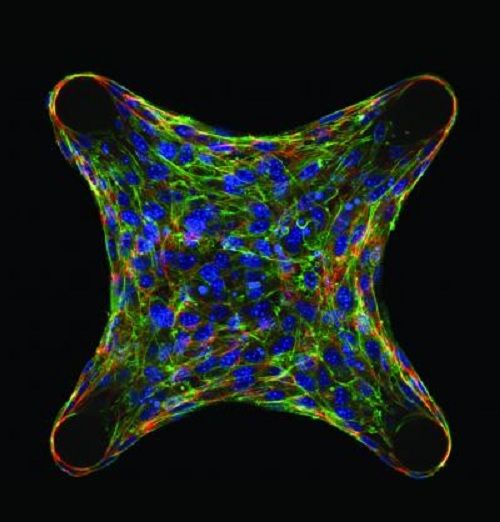Under Pressure: Peeking in on Contracting Cells

This Research in Action article was provided to LiveScience in partnership with the National Science Foundation.
Muscles stretch and contract when we walk, and skin splits open and knits back together when we get a paper cut. Each cell in our bodies is under pressure from both forces outside and inside the body.
As our cells perform their everyday tasks in our bodies, they experience what researchers call contractile forces; they are pushed and pulled as a part of a moving, changing tissue. Contractile forces are critical to our lives, influencing tissue development and structure, gene expression and behavior, cell signaling and wound healing.
To find out more about how contractile forces influence cell behavior, University of Pennsylvania bioengineer Christopher Chen and colleagues built a microscopic stretch-detector and compared measurements in real tissues to a computer simulation. What they found provides a new set of tools for studying tissues that stretch and contract and for exploring potential new medical applications.
Stretching tissues
First, Chen's team built a tiny, three-dimensional scaffold that mimics tissue in an organism. It is a set of flexible microscopic posts in a dish, over which they poured a mixture of cells and and elastic protein called collagen. Then they studied how the cells pulled and released the posts as they formed a web of tissue.
To measure contractile forces between the posts, the researchers developed a computer model. It divided the tissue into squares and, like a game of cellular Sudoku, plugged in numbers for each square until the tissue's forces balanced out. The model predicted that contractile forces varied throughout the tissue.
Sign up for the Live Science daily newsletter now
Get the world’s most fascinating discoveries delivered straight to your inbox.
The team returned to their experiment and saw that cells were reinforcing the tissue with collagen in the areas where the computer had predicted the highest forces and were making less collagen in areas with predicted lower forces.
Pressured cells
"It was almost like the cells could tell there was a lot more force or stress in certain regions," said Chen. "The computer models were really important in giving us an idea of where those stresses might be."
Chen said the work could lead to treatments that relax the contractile forces that cause facial scarring and fibrosis. It could also reveal new ways to help arteries relax to counteract high blood pressure as well as improve our understanding of why exercise keeps muscle and bone cells strong, potentially suggesting ways to reduce muscle atrophy and bone loss.
This research was supported by the National Institutes of Health and the National Science Foundation. To see more cool images of basic biomedical research in action, visit the Biomedical Beat Cool Image Gallery.
Any opinions, findings, and conclusions or recommendations expressed in this material are those of the author and do not necessarily reflect the views of the National Science Foundation. See the Research in Action archive.














